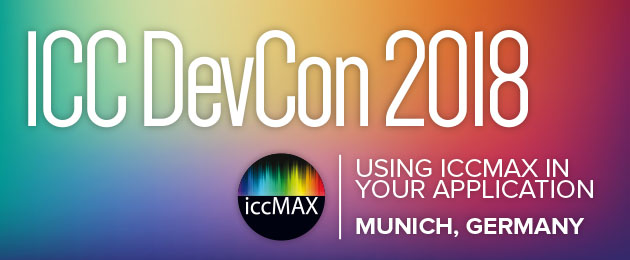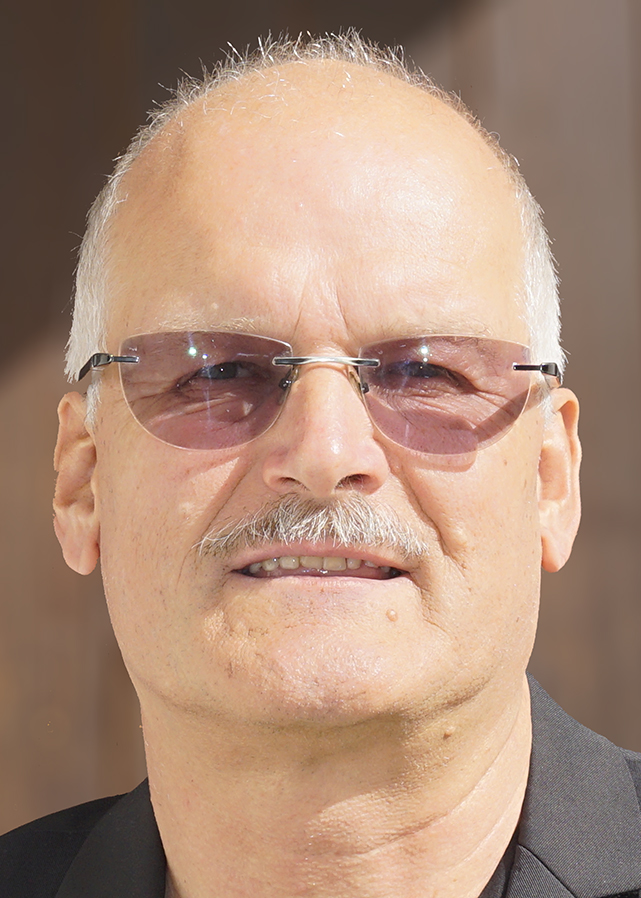- 2024
- Spectral Imaging Experts' Day
- Upcoming ICC Meetings
- 2023
- London Meeting Invited Speaker session
- 2022
- HDR Experts' Day
- 2020
- ICC DevCon 2020
- Munich, 10-11 February
- 2019
- ICC Color Experts' Day, Bressanone
- 2018
- ICC Color Symposium Hong Kong, 22 October
- Grand Rapids, MI, 30-31 May
- ICC DevCon 2018
- Munich, 25-26 February
- 2017
- Ryerson Toronto Graphic Arts Day, 13 October
- Toronto, 11-12 October
- Prague Graphic Arts Experts' Day, 29 June
- Prague, 27-28 June
- Tokyo, 19-20 April
ICC Developer Conference 2018

February 27 2018
Fogra Research Institute for Media Technologies
Einsteinring 1a
85609 Aschheim b. München
The International Color Consortium Developers Conference "ICC DevCon 2018" was held in Munich on February 27 2018. There was a panel of expert speakers on advanced colour management topics, and an iccMAX hands-on workshop.
See a video summary of the previous Developer Conference, DevCon2016.
To be added to the DevCon mailing list, email the ICC Technical Secretary
Program
| 8:30am | Conference Intro Note |
|
ICC Chair - William Li
|
|
 |
Introduction to iccMAX from the Business Perspective
William Li
The International Color Consortium (ICC) was established for the purpose of creating, promoting and encouraging the standardization of an open, vendor-neutral, cross-platform color management system architecture and components. The outcome was the development of the ICC profile specification. The ICC has completed the new specification, iccMAX that enables new ways of openly communicating about light, color and appearance. The result of this effort is that several real world scenarios can now be directly addressed using iccMAX based approaches that could not be easily addressed with previous open color management solutions. iccMAX represents a next-generation color management system that expands upon the existing ICC.1 profile format and architecture. After identifying some of the limitations of ICC.1, an introduction and overview of the concepts in the iccMAX specification will be presented. Examples of new features introduced in iccMAX include spectral processing, material identification and visualization, BRDF, new data types, an improved gamut boundary descriptor, and support for arbitrary and programmable transforms. The intent of this presentation is to provide an introduction to iccMAX with specific details and applications left to other presenters during the conference. William Li is currently Color Technology Manager with Eastman Kodak. William brings a diverse background in engineering, physics, and systems design and leads the team responsible for developing core color technology in such products as Kodak ColorFlow Software, Kodak Proofing System, Prosper, and Matchprint Virtual. He began his career in the graphic arts industry in 1997, joining the award-winning Prinergy PDF workflow team developing screening and calibration software at Creo, and has led the color technology group since the 2004 acquisition of Creo by Kodak. William is active in international standards work, including both ISO TC 130 as well as ICC, where he serves as chair. He has been a frequent speaker at the Printing Industries of America Color Management Conference, the Kodak Graphic Users' Association, the Hong Kong Color Management Symposium, and other venues. |


|
Implementing a Simple Color Model using the Calculator Element of iccMAX
Hauke Thomsen, Sebastian Eggert
In this talk, we show how the calculator element can be used to implement a spectral Neugebauer Color Model within an iccMAX profile. Such a profile allows for a simulation of the printing process. Since only the spectra of the full tones are required as input parameters for the profile, such a profile can be created from a few measured patches. Since the Neugebauer model is neither restricted to four printing color nor to these being CMYK, such a profile can be used to predict the overprint of spot colors. As an application, we will demonstrate the advantage of a spectral iccMAX workflow by showing the effect of varying lighting conditions. Sebastian Eggert graduated in mathematics and computer science and holds a Ph.D. in computer science from the Kiel University, Germany. Since 2015, he works as developer and color scientist at Heidelberger Druckmaschinen AG. Hauke Thomsen studied physics at the Kiel University where he received his diploma in 2011 and his Ph.D. in computational physics in 2015. In fall 2015, he started work at the research and development department of Heidelberger Druckmaschinen AG. He maintains and improves Heidelberg's CMM.
|
 |
N-color Characterization with iccMAX
Max Derhak
Six and seven color extended gamut printing processes are becoming more of the norm with the ability to set up printing processes that require less down time and improve productivity. However, the creation of accurate color management profiles that characterize N-color conditions for values of N greater than five poses significant challenges for implementers using ICC version 2 and version 4 (ICC.1) profiles. Work is underway within the ICC and ISO to standardize approaches to addressing these problems. Some of these challenges will be outlined in this presentation along with several strategies with associated tradeoffs that can be employed in creating profiles based on the iccMAX (ICC.2) specification. Max Derhak has worked for Onyx Graphics Inc. since 1990 where he currently functions in the role of Principal Scientist. Max has a Bachelors in Computer Science from the University of Utah, a Masters in Imaging Science at The Rochester Institute of Technology, and a PhD. in Color Science from RIT. Max admits to having a passion for both color and color technology. He was an initial contributor to the open source SampleICC and ICCXml projects which he continues to maintain. Max serves as a Co-Chair of the ICC as well as the Chair of the ICC Architecture Working Group, and has been a primary driving force in making iccMAX a reality. Max is also the initial contributor and maintainer of the iccMAX reference implementation - RefIccMAX.
|
 |
How can iccMAX benefit digital photography?
Phil Green
In some workflows, aspects of the v4 architecture represent a significant constraint. The requirement to chromatically adapt to D50 introduces the possibility of information loss, particularly where the image colorimetry is not defined in terms of the 1931 observer or 0:45 degree measurement. The inability to use spectral data requires conversion to one of the supported data colour spaces; and embedding profiles adds to file sizes, which can become significant when many images are used or where transmission bandwidth is limited. Moving to iccMAX enables each of these constraints to be removed. In an iccMAX profile it is possible to encode a much larger peak white luminance, and to apply luminance scaling in the CMM to the desired range. Complex tone mapping operators can be implemented using a wide ranger range of transform elements and floating-point data. Multichannel images can be converted to spectral or colorimetric PCS, and the channels can also be re-mixed according to the output requirements, for example for material identification or visualisation. All of this is interoperable with existing v2/v4 profiles, since a default conversion to the D50 PCS is built in to all v5 profiles. Finally, a v5 profile can simply include a pointer to the reference encoding used, instead of encoding the full transform in the profile. Phil Green is Professor of Colour Imaging at the Colour and Visual Computing Laboratory, NTNU in Gjøvik, Norway. He is also Technical Secretary of the International Color Consortium. Dr. Green received a MSc from the University of Surrey in 1995, and a PhD from the former Colour & Imaging Institute, University of Derby, UK in 2003. Following a career in the UK printing industry, he worked at London College of Communication, UK until 2012, most recently as Head of Research. Dr. Green's current research interests are around cross-media colour reproduction, and include characterization, appearance, metrology, image quality and colour difference. |
 |
Handling spectral images with standard and custom illuminants in iccMAX
Franz Herbert
Spectral images are the ultimate in representing a scene from a color point of view. While many organizations have built their own spectral scanning device there are very few commercial spectral capture systems on the market. iccMAX contains a spectral PCS that allows spectral images to be viewed and processed in a variety of ways. A main benefit of a spectral capture is the ability to view it in different simulated viewing environments, this includes spectral measurements of any light source. This presentation will describe and demonstrate this process. Franz Herbert has been developing color technologies and color management applications for 30 years. His ColorBlind system was the first comprehensive color management system that allowed end users to build ICC profiles for all devices. He is now the color technologist at basICColor GmbH. He holds 4 patents related to color management.
|
 |
Implementing Observer Metamerism Correction on Wide Color Gamut Display using iccMAX Framework
Chris Bai
New technologies have been developed to widen the color gamut on displays, and wide color gamut display in theory can improve the accuracy in soft proofing application, and exhibit a better reproduction of the real world colors. Quantum Dot technology is one of the technologies which enable displays to achieve full coverage of Adobe RGB, DCI-P3 and the latest Rec. 2020 color gamut. The technology involves using UV and the blue portion of the light spectrum to excite the chemicals to produce narrow band green and red lights. However, recent studies have shown that displays with narrow band spectrum will result in a lesser perfect reproduction than CCFL displays can achieve. The reason was believed to be the variation in each observer's color matching function. A small variation will result in a huge difference in XYZ values due to concentrated energy in particular bandwidths. In this study, observer's color matching function was categorized and the spectral characteristic of the display was measured. The individual observer color matching function along with the spectral data of the wide color gamut display were encoded with the latest iccMAX framework to deliver an improved performance comparing with no observer metamerisim correction in color matching experiment. Chris Bai is the Chief Color Expert and Product Manager at BenQ Corporation where he developed the first printing industry certified color management monitor from BenQ. His responsibility also includes software developing for color application in different industries, standards developing and color education. He was the Director of the R&D Division at Printing Technology Research Institution in Taiwan and a fellow researcher at Display Technology Center in Industrial Technology Research Institution. Coming from a mixed background of printing and display technology research, he believes making soft-proofing accessible is the future, and that was his mindset when designing the product. He received his BASc. in Computer Engineering from University of British Columbia, Canada, and his passion in photography had lead him into the world of color. He received his MSc. in Color Science from University of Leeds, UK. His experience and education in color science has allowed him to provide extensive color management training to printers, photographers, designers and everyone who is interested in color management. |
 |
Correction of Display Viewing Angle with iccMAX
James Vogh
The color and intensity of the light from a LCD display panel typically varies with the angle that the display is viewed from. ICC version 4 display profiles characterize a display from only one viewing angle (typically perpendicular to the surface). The characterization of the display by the profile can therefor have poor accuracy unless the display is view from the same angle as the profile was made. Additionally, if the display is viewed from a close distance, the viewing angle can have a significant variation across the screen. Various head and eye tracking technologies can track an observer's location while a display is being observed so that an observer's viewing angle can be computed. ICCMax includes a set of profile tags that allow a display to be characterized for both viewing angular and spatial location. This presentation will demonstrate a method of measuring a display from different viewing angles, building an ICCMax profile for the display with the measurement data, and applying the profile with a GPU. Measurement is made with a colorimeter mounted on a tripod and aimed at the center of the display screen. iccMax supports a new set of tag formats that are similar to the A2B & B2A tags but also support angular and spatial input parameters. The angular inputs are the azimuth and zenith of the viewing vector and the spatial parameters are the spatial coordinates on the screen. The new tags are implemented as a multi-processing element type and can contain calculator elements. The profile to be demonstrated is an implemented as a matrixTRC profile with multiple viewing angles. The calculator element is used to select the correct set of curves and matrices to use, apply the curves and matrices, and interpolate the results for the current viewing angle. The application of the profile is demonstrated as openGL shader code that implements the elements of the multi-processing element. James Vogh received his M.S. degree in Electrical Engineering from the University of Tulsa in 1990 and a Ph.D. in Cognitive and Neural Systems from Boston University in 1998. During his Ph.D. he developed a neural network architecture for recognizing 3D objects. At Monaco Systems he developed ICC based calibration technologies. Since 2004, he is a principle color scientist at X-Rite where he continues to develop calibration technology as he conducts advanced research in color science. |
 |
Color and translucency definition and workflow for graphical 3D printing
Philipp Urban
Advances in multimaterial 3D printing have the potential to reproduce various visual appearance attributes of an object in addition to its shape. Since many existing 3D file formats encode color and translucency by RGBA textures mapped to 3D shapes, RGBA information is particularly important for practical applications. In contrast to color (encoded by RGB - typically interpreted as a standard RGB color space such as sRGB or Adobe RGB), which is specified by the object's reflectance, selected viewing conditions and a standard observer, translucency (encoded by A) is neither linked to any measurable physical nor perceptual quantity. Thus, reproducing translucency encoded by A is open for interpretation. In this talk, I will describe a rigorous definition for A suitable for use in graphical 3D printing, which is independent of the 3D printing hardware and software, and which links both optical material properties and perceptual uniformity for human observers. The definition is derived from the absorption and scattering coefficients of virtual homogenous reference materials with an isotropic phase function, and allows a simple adjustment of A preserving the translucency appearance if an object is rescaled for printing. Determining the value of A for a real (potentially non-homogenous) material, can be achieved by minimizing a distance function between light transport measurements of this material and simulated measurements of the reference materials. Such measurements can be conducted by commercial spectrophotometers used in graphic arts. At the end of the talk, I will give an overview about the color-and-translucency workflow implemented in Fraunhofer IGD's 3D printing driver Cuttlefish. Philipp Urban received the MS degree in mathematics from the University of Hamburg, Germany, and the PhD degree from the Hamburg University of Technology, Germany, in 1999 and 2005, respectively. From 2006 to 2008, he was a Visiting Scientist with the Munsell Color Science Laboratory, Center for Imaging Science, Rochester Institute of Technology, NY,USA, and headed afterward the Color Research Group at the Institute of Printing Science and Technology, Technische Universität Darmstadt, Germany. Since 2013, he has been the Head of the Competence Center 3D Printing Technology with the Fraunhofer Institute for Computer Graphics Research IGD, Darmstadt, Germany. He is an adjunct professor at the Norwegian Colour and Visual Computing Laboratory, Department of Computer Science, Norwegian University of Science and Technology (NTNU), Gjovik, Norway. His research interests include 3D printing, spectral imaging, image quality, and material appearance reproduction.
|
 |
Implementing colour appearance transforms in iccMAX
Michele Conni
iccMAX contains the IccCAM colour appearance model as a built-in function, which allows the user to implement a wide range of different elements. This talk will demonstrate how to apply different sensor adjustment transforms (SAT) between different illuminants, and what are the results of this process. Michele Conni graduated in engineering physics at the Polytechnic University of Milan in 2015, with specialization in optics and photonics. He is currently studying for a PhD in computer science at the Norwegian Colour and Visual Computing Laboratory, in collaboration with Barbieri Electronic, where he works in the research and development group.
|
 |
An image based multi-angle measurement setup
Aditya Sole
Gonio-spectrometers and multi-angle spectrophotometers are successfully used for performing bi-directional measurements of non-diffuse materials like metallic inks and paints used in the print and packaging industry and car paint industry. Using a gonio-spectrometer for bi-directional measurements is time consuming and an expensive process. To overcome these limitations, we use a simple image-based measurement setup to perform angular measurements along with different reflection models to measure and simulate bidirectional reflectance distribution function (BRDF) of a material. The setup is validated by comparing the setup measurements against measurements performed using a commercially available gonio-spectrometer. Results obtained show that the setup can be used for bidirectional measurements with a known uncertainty. Aditya Sole completed his bachelors from PVGs College of Engineering and Technology, Pune University, India in year 2005. In 2007, he completed his MSc in Digital Colour Imaging from London College of Communication, University of the Arts, London, UK. From 2008 till 2012 he worked as a Laboratory Engineer at the Norwegian Colour and Visual Computing Laboratory, Gjøvik University College, Gjøvik, Norway. Since, 2012 he is working as a Project Manager and is studying for a PhD at the Norwegian Colour and Visual Computing. |
|
1:00pm |
Lunch Break with table presentations |


|
WORKSHOP Hands-on with RefIccMAX
Led by Max Derhak (Onyx Graphics) with Kai-Uwe Behrmann In this session a hands-on workshop will be conducted utilizing the reference implementation library and tools for iccMAX. RefIccMAX represents a jumping board by which one can begin to create and use iccMAX profiles. Topics that will be covered include:
Some familiarity with ICC color management is recommended. Though some software programming topics will be covered, extensive knowledge of programming is not required to benefit from this workshop. RefIccMAX project setup and build in Linux and XCode This part of the workshop will show the setup, compilation and integration of RefIccMAX as a sub-project for a custom code project. Covered will be the Linux and Mac OS platforms. Kai-Uwe Behrmann co-initiated the OpenICC group and brought ICC end to end Color Management to the attention of the greater open source graphics and desktop communities. He works on desktop standards, specifications and implementations. As a volunteer, he lends a helping hand during the conceptual phases of open source projects like Xorg, Gutenprint, Ghostscript, Sane, Wayland, Cairo, Qt and other projects or helps spotting bugs and implementation gaps. He is the maintainer of the Oyranos CMS project, which targets at implementing ICC style color management and other desktop specifications, testing new concepts and demonstrating technological possibilities. His software stack integrates with Mac OS, some GPU powered display managers on Linux/Xorg and the KDE Systemsettings panel, online ICC device profile distribution with Taxi DB and some console and graphical utilities. Lately he explored Android + Qt/QML development, environment dependent display adaption and Smart CMM's using device link profiles.
|
| DevCon Sponsors | |||
 |
 |

